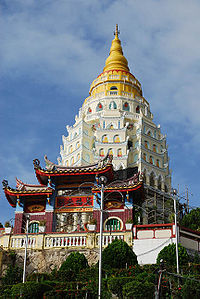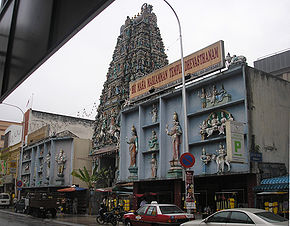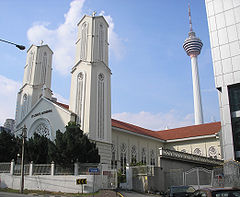
Masjid Negara
The Masjid Negara is the national mosque of Malaysia, located in Kuala Lumpur. It has a capacity of 15,000 people and is situated among 13 acres (53,000 m2) of beautiful gardens. The original structure was designed by a three-person team from the Public Works Department - UK architect Howard Ashley, and Malaysians Hisham Albakri and Baharuddin Kassim. Originally built in 1965, it is a bold and modern approach in reinforced concrete, symbolic of the aspirations of a then newly-independent Malaysia.
Its key features are a 73-metre-high minaret and an 18-pointed star concrete main roof. The umbrella, synonymous with the tropics, is featured conspicuously - the main roof is reminiscent of an open umbrella, the minaret's cap a folded one. The folded plates of the concrete main roof is a creative solution to achieving the larger spans required in the main gathering hall. Reflecting pools and fountains spread throughout the compound. Local reports have drawn metaphors about the significance of its main roof: 18 points symbolise the (then) 13 states of Malaysia and the Five Pillars of Islam. However, design member Hisham Albakri revealed in an interview with Badan Warisan Malaysia that this was erroneous.
History
Malaya gained its independence from the British government on 31 August 1957. Major development programs in areas of economy, social and architecture were actively implemented in line with the new government. The programs were also to portray new progressive culture and achieved democracy. Therefore, on 30 July 1957, in the meeting of the Federal Executive Council an idea to build a national mosque as a symbol of the country’s independence was mooted. In another meeting on 5 March 1958, Chief Ministers of the eleven states in the Federation of Malaya, a proposal was made to name the mosque Masjid Tunku Abdul Rahman Putra Al-Haj, in recognition of Yang Teramat Mulia Tunku Abdul Rahman Putra Al-Haj’s efforts in guiding the country to gaining independence. However, Tunku refused this honour; on the contrary he named it Masjid Negara in thanksgiving for the country’s peaceful independence without bloodshed .
The mosque underwent major renovations in 1987, and the once-pink concrete roof is now clad in green and blue tiles. Today, Masjid Negara continues to stand sleek and stylish against the Kuala Lumpur skyline. An underground passage leads to the National Mosque located near the railway station, along Jalan Sultan Hishamuddin. Its unique modern design embodies a contemporary expression of traditional Islamic art calligraphy and ornamentation. Near the mosque is the Makam Pahlawan (Heroes' Mausoleum), a burial ground of several Malaysian politicians. Makam Pahlawan is a 7-pointed star concrete roofed structure.
Imams of Masjid Negara
- Haji Ghazali Abdullah (1965)
- Hj. Mohd Salleh Hassan Farid
- Datuk Sheikh Abdul Mohsein ibn Hj. Salleh (1974-1975)
- Dato' Hj. Ahmad Shahir ibn Haji Daud (1975-1980)
- Dato' Hj. Hassan Din Al-Hafiz (1981-1983)
- Dato' Hj. Ahmad Shahir ibn Haji Daud (1984-1992)
- Haji Arifin Harun (1992-1993)
- Haji Taib Azamudden Md. Taib (1993-1999)
- Haji A. Jalil ibn Sindring (1999-Sep. 2001)
- Haji Wan Halim ibn Wan Harun (2001-2004)
- Dato' Haji Kamaruddin ibn Hj Zakaria (2005-2006)
- Tan Sri Dato' Syaikh Hj.Ismail ibn Hj.Muhammad (February 2007-current.)

Kek Lok Si
Kek Lok Si Temple
The Kek Lok Si Temple (Penang Hokkien for "Temple of Supreme Bliss" or "Temple of Sukhavati"; Simplified Chinese: 极乐寺; Traditional Chinese: 極樂寺) is a Buddhist temple situated in Air Itam in Penang and is one of the best known temples on the island. It is the largest Buddhist temple in Southeast Asia. Mahayana Buddhism and traditional Chinese rituals blend into a harmonious whole, both in the temple architecture and artwork as well as in the daily activities of worshippers.
History
The construction of the temple began in 1890 and was inspired by the chief monk of the Goddess of Mercy Temple at Pitt Street. With the support of the consular representative of China in Penang, the project received the sanction of the Emperor Guangxu, who bestowed a tablet and gift of 70,000 volumes of the Imperial Edition of the Buddhist Sutras. The primary benefactor of the Kek Lok Si Temple in 1906 was none other than Kapitan Chung Keng Quee. In 1930, the seven storey main pagoda of the temple or the Pagoda of 10,000 Buddhas, was completed. This pagoda combines a Chinese octagonal base with a middle tier of Thai design, and a Burmese crown; reflecting the temple's embrace of both Mahayana and Theravada Buddhism.In 2002, a 30.2m bronze statue of the Kuan Yin was completed and opened to public. The statue is located on the hillside above the pagoda.
A temple in the making
As the fairly recent date mentioned above may suggest, the temple is still growing. Generous donations from the affluent Chinese community allow the construction of additional buildings. The current focus is to create an ornate shelter for the Kuan Yin statue. 16 carved dragon pillars are being built, the concentric roof will be inspired by classical Ming architecture, reminiscent of the roof of Prayer Hall for Good Harvest in the Temple of Heaven in Beijing.
Visiting the Temple
Most visitors approach the temple as they ascend a stairway, roofs of which provide shelter to a multitude of shops selling souvenirs and other - mostly secular - commodities. They pass by a so-called Liberation Pond, following the buddhist tradition of merit-making, turtles may be released into freedom, albeit a limited one. The temple itself consists of several large halls for assembly and prayer, here, statues of Buddha, various Bodhisattvas as well as Chinese gods are being venerated. Intricate woodwork, often brightly painted and a plethora of lanterns add to the visual impression. There is an inclined lift to carry pilgrims and visitors further uphill. On the elevated platform, you can find a pond filled with Koi and the towering statue of Kuan Yin, Goddess of Mercy, which can also be regarded as Avalokitheshvara, Bodhisattva of Universal Compassion.

Sri Mahamariamman Temple, Kuala Lumpur
Founded in 1873, the Sri Mahamariamman Temple is the oldest and richest Hindu temple in Kuala Lumpur. It is situated at edge of Chinatown in Jalan Bandar (formerly High Street). In 1968, a new structure was built, featuring the ornate 'Raja Gopuram' tower in the style of South Indian temples. From its inception, the temple provided an important place of worship for early Indian immigrants and is now an important cultural and national heritage.
History
The Sri Mahamariamman Temple was founded by K. Thamboosamy Pillai in 1873 and was initially used as a private shrine by the Pillai family. The family threw the temple doors open to the public in the late 1920s and eventually handed the management of the temple over to a board of trustees. This is the oldest functioning Hindu temple in Malaysia. It is also reputed to be the richest in the country. The temple was originally sited somewhere near the Kuala Lumpur Railway Station. It shifted to its present location along Jalan Tun H.S. Lee (next to KL's Chinatown) in 1885.
The initial attap structure was demolished in 1887 and a brick building was erected in its place. That structure was demolished to make way for the current temple building which were completed in 1968. The impressive gateway to the temple, known as the gopuram, was completed in 1972. The new temple was consecrated in 1973.
Architecture
Gopuram
Built in the south Indian style, the temple most outstanding feature is the impressiven 5-tiered gopuram (tower). It is the tallest structure in the temple. The dramatic 22.9m (75ft) high pyramid-shaped gate tower is decorated with depictions of Hindu gods sculpted by artisans from southern India. The chief sculptor was the late S. T. Muniappa from Tamil Nadu and is credited for creating the 228 idols on the gopuram.
Main Prayer Hall
The temple's main shrine (garbagraham) to Sri Maha Mariammman. This Temple resembles the form of a human body lying on its back with the head positioned towards the west and the feet towards the east. The temple's 5-tiered gopuram corresponds to the feet of the body. It is the threshold between the material and spiritual world. At the rear is the garbagraham or sanctum sanctorum, which corresponds to the head. It is a freestanding structure with its own roof and walls and has one entrance that faces east. This is the inner sanctum where the chief deity Sri Maha Mariamman is installed. The priest stands in front of the garbagraham when performing the puja (prayers). Within the temple is a main prayer hall with richly decorated ceilings. The location of three shrines in the main temple is marked by an ornately embellished onion dome which can be seen from outside. There is also four smaller shrines located peripherally around the main temple building. Lord Ganesha is in the shrine on the left and Lord Muruga, his brother, is on the right. Ganesh is also found at the entrance as he is the remover of obstacles. The eight female figures adorning the pillars inside the temple are of Lakshmi (Goddess of Wealth). Once every 12 years, in keeping with Hindu tradition, the temple is reconsecrated.
Silver Chariot
A silver chariot is housed within the premises. This chariot is a prominent feature during the annual Thaipusam festival. It used during this occasion for transporting the statuettes of Lord Muruga and his consorts (Valli and Teivayanni) through the city streets to Batu Caves. It made its debut in 1983 and was built at a cost of RM350,000 using 350 kilograms of silver. The chariot was made in India and shipped here in 12 parts to be assembled. It is 6.5 metres tall and has 240 bells and a pair of horses on it. Before the silver chariot, a wooden one was used which was made 1930 by Indian craftsmen at a cost of RM50,000.
Bangunan Mariamman
Recently, the Sri Maha Mariamman Temple Dhevasthanam has after a 40 year old wait, finally got its own building. The RM 13 million six storey building, located behind the temple in Jalan Tun H.S Lee was officially opened by Works Minister and MIC President Datuk Seri S. Samy Vellu. Temple chairman R. Nadarajah said the idea to construct the building was mooted by Datuk Seri S. Samy Vellu 38 years ago when he was a committee member of the temple. Known as Bangunan Mariamman, the building is situated beside the Klang Bus Station and opposite the Putra LRT station. The building which is connected to the temple, has two floors of basement car parks, three floors for two auditoriums and a hall.
The Deity
Mariamman is popularly worshipped by overseas Indians, especially Tamils because she is looked upon as their protector during their sojourn to foreign lands. Mariamman is a manifestation of the goddess - Parvati, an incarnation embodying Mother Earth with all her terrifying force. She is associated with disease and fever and protects her devotees from unholy or demonic events.
Administration
The Sri Mahamariamman Temple is managed by the Board of Management of Sri Maha Mariamman Temple Devasthanam, which also manages the Batu Caves Sri Subramaniam Temple and the Kortumalai Pillaiyar Temple. It also performs the role of Hindu Religious Consultant to the Government of Malaysia in determining the Hindu yearly calendar.
Festivals
The temple is particularly packed on Deepavali with devotees eager to offer their prayers on the holy day. Also on the holy day of Thaipusam, thousands of devotees throng the temple at the wee hours of the morning to start a long procession leading up to Batu Caves as a religious undertaking to Lord Muruga. They carry containers containing milk as offering to Lord Muruga either by hand or in huge decorated carriers on their shoulders called 'kavadi'.

St. John's Cathedral, Kuala Lumpur
St. John's Cathedral, as seen towards the northeast. The Kuala Lumpur Tower is visible in the picture obove. St John's Cathedral is a whitewashed cathedral with twin spires, located to the north of Kuala Lumpur, the capital city of Malaysia. It is a Roman Catholic church and is aligned to the Archdiocese of Kuala Lumpur. It was originally opened in 1883, making it one of KL's oldest buildings. January 8th is the anniversary of its dedication.
St John's Cathedral is located next to St. John's Institution, which is known for its Grecian-Spanish architecture. The school derives its name from the cathedral and was set up by the Lasallian Brothers. Due to its location ascending Bukit Nanas, it is also in close contact to Convent Bukit Nanas, Bukit Nanas Forest Reserve and Kuala Lumpur Tower. It is accessible from the Masjid Jamek LRT station and the Bukit Nanas Monorail station.